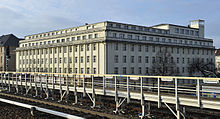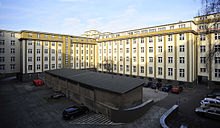Heereswaffenamt


The Heereswaffenamt ( HWA ) was the central office for the technical development and manufacture of weapons , ammunition and equipment for the German army ( armaments research ). It had about 5,000 officials and officers.
history
The organization's predecessors were the Rifle Examination Commission and the Artillery Examination Commission , which were dissolved in 1918. On November 8, 1919, the Waffenamt ( inspection for weapons and equipment ) was founded in the Reichswehr Ministry under Colonel (later Lieutenant General ) Wurtzbacher and on May 5, 1922, it was given the name Heereswaffenamt (HWA).
In peacetime it was directly subordinate to the Commander-in-Chief of the Army , but since the beginning of the attack on Poland on September 1, 1939, it was subordinated to the Chief of Army Armaments and Commander of the Replacement Army Friedrich Fromm .
The headquarters of the HWA was in Berlin, Hardenbergstrasse 29. The building was destroyed in World War II and later demolished. The Jebensstrasse / Hertzallee building complex was also used by the HWA.
Weapons, devices and equipment were tested at the Army Research Centers in Kummersdorf and Peenemünde and at other locations.
The Heereswaffenamt was reorganized several times during the war. On July 1, 1944, it consisted of the staff with the research department and six official groups: central tasks, development and testing, chief engineer, industrial armament, weapons and equipment, industrial armament, ammunition, acceptance.
Outline weapon office testing
- Wa Prüf 1 - Ammunition and Ballistics Department
- Wa Prüf 2 - Infantry Division
- Wa Prüf 4 - Artillery Department
- Wa Prüf 5 - Pioneer and Railway Pioneer Department
- Wa Prüf 6 - Armor and Motorization Department
- Wa Check 7 - News Department
- Wa Prüf 8 - Department of optics, metrology, army weather service, fire control and card printing
- Wa Prüf 9 - Gas protection department
- Wa Prüf 11 - special equipment department
- Wa Prüf 12 - Department of test sites
tasks
In the course of the armament of the Wehrmacht , the importance of the HWA grew:
- Development of new weapons, devices and ammunition (development and testing)
- Bulk procurement of weapons, equipment and ammunition (industrial armaments)
- Technical basics, as well as preparation and establishment of mass production in industry
- Acceptance of finished weapons, equipment and ammunition
- Recording and cataloging of prey weapons in "identification sheets for foreign equipment"
Chiefs of the Army Weapons Office
- Lieutenant General Ludwig Wurtzbacher (1870–1926) from June 1, 1920 to March 1, 1925
- Major General Erich von Botzheim (1871–1961) from March 2, 1925 to February 28, 1926
- Lieutenant General Max Ludwig (1871–1961) from March 1, 1926 to May 30, 1929
- Lieutenant General Alfred von Vollard-Bockelberg (1874–1945) from June 1, 1929 to November 30, 1933
- Major General / Lieutenant General Kurt Liese (1882–1945) from December 1, 1933 to February 28, 1938
- General of the Artillery Karl Becker (1879–1940) from March 1, 1938 to April 8, 1940
- General of the Artillery Emil Leeb (1881–1969) from April 16, 1940 to February 1, 1945
- General of the Infantry Walter Buhle (1894–1959) from February 1 to May 8, 1945
Situation in 1945
The expansion of the Army Weapons Office to the Wehrmacht Weapons Office ordered by the Chief of Army Armaments, General of the Infantry Walter Buhle, on January 15, 1945, did not go beyond the beginnings because of the worsening situation on the fronts. In mid-April 1945 most of the Army Weapons Office, along with its boss, was relocated to southern Bavaria and finally dissolved by order of April 27, 1945.
A famous development of the HWA was the " Dora " railway gun . Before the establishment of the research institute in Peenemünde, initial research into rocket technology was carried out here.
literature
- Peter Zimmermann: Technology for armaments and war. 4. Defense technology and defense science between the world wars. (Messages from the Institute for Mechanics 89, 1.) Neubiberg 1989.
- Helmut Maier: Research as a weapon. Armaments research in the Kaiser Wilhelm Society and the Kaiser Wilhelm Institute for Metal Research 1900–1945 / 48. 2 volumes. Wallstein, 2007, ISBN 978-3-8353-0109-2 .
- Günter Nagel: Science for War. The secret work of the research department of the Heereswaffenamt , Stuttgart 2012, ISBN 351510173X .
- Rüdiger vom Bruch , Brigitte Kaderas (ed.): Sciences and science policy. Steiner, Stuttgart 2002, ISBN 3-515-08111-9 .
- Michael Heidler: German production marks up to 1945 , visor edition, VS-Medien GmbH, Bad Ems, ISBN 3-9811018-7-1 .

